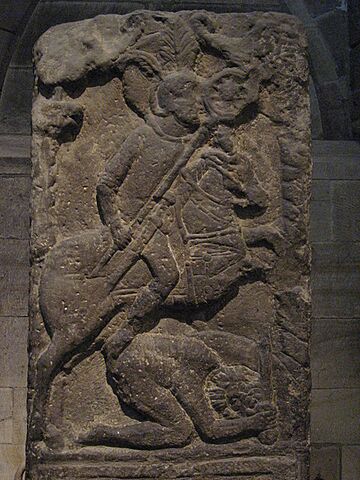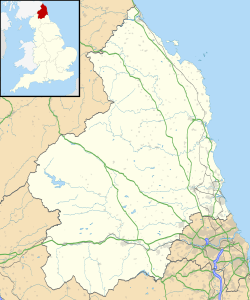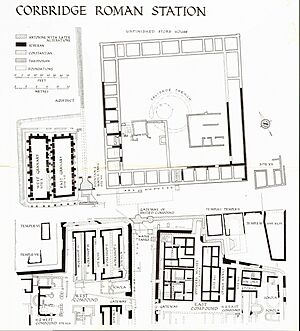Coria (Corbridge) facts for kids
Quick facts for kids Coria (Corbridge) |
|
|---|---|

Ruins of Corbridge’s Roman granaries
|
|
| Alternative name(s) | Coriosopitum, Corsopitum or Corsobetum |
| Founded | c. 84 AD |
| Place in the Roman world | |
| Province | Britannia |
| Structure | |
| — Stone structure — | |
| — Wood and earth structure — | |
| Built | c. 84 AD |
| Stationed military units | |
| — Alae — | |
| I Petriana ? | |
| Location | |
| Coordinates | 54°58′42″N 2°01′59″W / 54.9784°N 2.03316°W |
| County | Northumberland |
| Country | England |
| Reference | |
| UK-OSNG reference | NY981647 |
| Site notes | |
| Condition | Ruined |
Coria was an important Roman fort and town. It was located about 4 kilometers (2.5 miles) south of Hadrian's Wall. This site was in the Roman province of Britannia, which is now England.
Coria was a very important place because of its location. It sat where a major Roman road, called Dere Street, met the River Tyne. Another Roman road, the Stanegate, also ran through Coria. The Stanegate was an early Roman frontier line.
Today, the Corbridge Roman Site is in the village of Corbridge in Northumberland. English Heritage looks after the site. You can visit it and see some of the ancient ruins. There is also a museum there.
Contents
What's in a Name?
The full Roman name for Coria is not completely known. In old records, it appears as Corstopitum or Corie Lopocarium. These names might have been written down incorrectly. Some historians think the name could have been Coriosopitum, Corsopitum, or Corsobetum.
However, ancient Roman writing tablets found nearby, called the Vindolanda tablets, show a simpler name. People living there often just called it Coria. This name meant a local tribal center. The second part of the name probably referred to a local tribe. This tribe was part of the Brigantes, a large group of people in northern Britain.
History of Coria
Early Life at Coria
Before the Romans arrived, people lived here during the British Iron Age. Archaeologists have found evidence of round houses from that time.
The first Romans built a supply camp nearby. It was called the Red House Fort. This camp helped support the Roman general Gnaeus Julius Agricola in his military campaigns.
Roman Forts at Coria

Around AD 84, after Roman victories in what is now Scotland, a new fort was built at Coria. This fort was made with earth walls and wooden gates. It was part of the Stanegate frontier system, which was a line of connected forts.
Inside this fort, there were barracks for soldiers. There was also a headquarters building, a home for the commander, and places for staff. Workshops and granaries (buildings for storing grain) were also part of the fort. A cavalry unit of 500 soldiers, possibly called the Ala Gallorum Petriana, likely lived here. This first fort burned down in AD 105.
A second timber fort was then built. It protected an important crossing point over the River Tyne. At this time, the Roman frontier was between the Solway Firth and the River Tyne.
Around AD 120, Hadrian's Wall was built a few kilometers north of Coria. The fort at Coria was rebuilt again. It probably housed infantry soldiers, keeping them close but not directly on the Wall. About 20 years later, the Roman frontier moved even further north. The Antonine Wall was built in Scotland. At this time, the first stone fort was built at Coria. This happened under Governor Quintus Lollius Urbicus.
Archaeologists have studied the forts at Corbridge for many years. Their reports show how the forts changed over time. They started as earth and timber forts before becoming stone buildings. During excavations, a special collection of metal objects, known as the Corbridge Hoard, was found inside the fort.
Coria Grows into a Town
By AD 163, the Romans moved back to Hadrian's Wall. The army largely left Coria. The fort walls were taken down, and a big rebuilding project began. This time, the site became more like a town.
Several temples were built. Then came more granaries, a fountain house, and a large courtyard area. This courtyard might have been planned as a civilian market square or a military storage and workshop area. However, it was never fully finished as originally planned.
In the early 3rd century, more construction happened. Two military supply depots were built in the town. These depots were connected to the Second and Sixth Legions. They likely helped supply the northern military campaigns of Emperor Septimius Severus.
An impressive house was built in the 3rd or 4th century. It might have been home to an important Roman official. Coria was probably a busy market center. It traded in lead, iron, and coal from the area. Farming was also important, which is why there were so many granaries. A pottery store has also been found. We don't know exactly when people stopped living at Coria. It's unclear if the site was still occupied when the Anglo-Saxons arrived and founded the nearby village of Corbridge.
The famous Corbridge Hoard was discovered here.
Finding Coria Again
The first excavations at Coria happened in 1861. However, the records from these early digs were lost. Only a short summary of what was found was ever published.
More organized excavations began in 1906. These were led by Francis J. Haverfield and supervised by Leonard Woolley. These early digs showed how much history was hidden at Coria. From 1907 to 1914, excavations continued every year. Many students and scholars worked on these digs. This made Coria one of the first places in Britain where archaeologists were trained. Later, in the 1960s and 1970s, Brian Dobson also ran training excavations for adults at Corbridge.
The Tombstone of Flavinus

In 1881, workers at Hexham Abbey in Northumberland found something amazing. They discovered a Roman tombstone built into the stonework of the abbey's south porch.
This stone is beautifully carved. It shows a Roman cavalry standard-bearer riding a horse and defeating an enemy. The inscription on the stone tells us it honors Flavinus. He was an officer in the ala Petriana, a Roman cavalry unit. Flavinus died at age 25 after serving for seven years.
The ala Petriana is known to have been stationed at Corbridge. This tombstone likely dates back to the late first century. It probably once stood in the Roman military cemetery near the fort at Coria. Today, you can see this impressive tombstone on display in Hexham Abbey.
See also
 In Spanish: Coria (Corbridge) para niños
In Spanish: Coria (Corbridge) para niños



